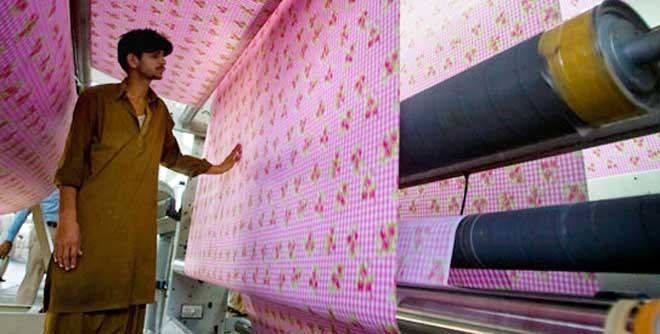

Although the government expects an increase in export earnings from the textile sector during the current fiscal year after the grant of the GSP plus status to Pakistan by the European Union from January 1, 2014, textile manufacturers and exporters view the status as a major challenge -- due to the problems faced by the local textile industry.
This new status was granted to Pakistan after the European Parliament passed the resolution by 406-186 votes on December 12, 2013.
The challenges and problems are many: the growing input cost due to energy crises, difficulty in accessing bank finances, increasing mark-up rates on bank loans, growing electricity and gas tariff and worsening law and order situation are the main problems the textile manufacturers and exporters are facing these days in Pakistan.
Although the government has allowed some concessions, such as preference in gas supply to the industries and some financial incentives under the Textile Policy, still the textile industry is feeling the squeeze.
Many Pakistani textile exporters are more concerned about the conditionalities attached to the facility -- the ratification of 27 international conventions by Pakistan, which means the exporters have to ensure that instruments relating to human rights, labour standards, environment and good governance are implemented to make them eligible to export duty-free products to the European markets.
Interestingly, the Pakistan government has already ratified all these conventions, but their compliance is always a matter of concern. Labour organisations and human rights and environmental activists have been complaining about non-compliance of these international conventions in Pakistan and improper working conditions.
Due to lack of occupational health facilities in factories, exporters are facing various restrictions in the international markets. The incident of fire in a garment factory in Karachi, which caused death of over 250 workers in September 2012, has raised eyebrows of international buyers as the factory was exporting textile finished products to Europe, especially to Germany.
Another important issue for Pakistani exporters is to comply with 27 international conventions devised by the EU as monitoring mechanisms -- through third-party monitors, including civil society organisations.
"We don’t see Pakistan increasing garment exports in the near future," says Majyd Aziz, a leading garment exporter and a former Chairman of Karachi Press Club, adding, even exporting textile products worth US$ 500 million this fiscal year is difficult, leave aside the government expectations to increase textile exports to US$ 26 billion in five years because of the GSP plus status.
Aziz urges the government to play a leading role in ensuring compliance of all the international conventions.
For Pakistani exporters, there is also a scope for increasing textile exports to the traditional markets, such as the USA as, currently, Pakistan has a share of only 1.5 per cent in the global textile exports. The US is also likely to favour Pakistan for its active participation in the war against terror.
Pakistan’s exports have not grown in recent years due to other reasons, too, like recession in the international markets and growing gas, electricity and fuel costs at home. The local conditions and price hike have resulted in slowing down production and even closure or shifting of some of manufacturing units to other countries.
The labour unrest in textile hub Faisalabad has further hampered the production of textile products. Due to the security problem and extortion menace in Karachi many manufacturers have either closed down their businesses or have moved to other cities or countries.
Despite the fact that a federal textile ministry has been established, significant improvement in the textile exports has not been reported. The textile ministry announced a five-year Textile Policy for 2009-2014 during the previous government of Pakistan People’s Party, which had envisaged the growth in textile exports from US$ 13.8 billion in 2009 to US$ 25 billion by 2014. It had envisaged an additional investment of US$ 8 billion largely to be undertaken by the private sector, with public sector investing in infrastructure, skills development, marketing and information and communications technology and private investors investing in expansion of their production facilities.
The policy was to provide various incentives to the local manufactures besides the creation of a special ‘Textile Investment Support Fund’ and a ‘Technology Upgradation Fund’ for the entire textile sector.
But, unfortunately, the Textile Policy has not achieved its targets despite the incentives to the textile industry and the policy would end this year without even increasing the textile exports to US$ 15 billion.
The textile exports are still hovering around US$ 13 billion per annum. Pakistan’s total exports were US$ 10.367 billion during the first five months of the current fiscal year (July-November 2013).
According to the latest figures of the Federal Bureau of Statistics, Pakistan exported textile goods worth US$ 6.46 billion during July-December 2012 against the US$ 5.95 billion during the same period last year, thus registering an increase of 8.55 per cent.